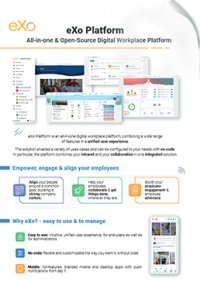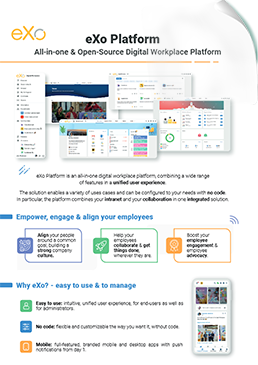

FREE DATASHEET
Download the eXo Platform Datasheet and discover all the features and benefits
We’re still in the depths of winter, and summer seems a long way off, so we’re already thinking about going on a diet. Yet taking care of your mental health can’t wait!

📱 5 hours a day on our screens (Study by french public health and University of Paris 13, 2020)
📩 135 emails received per day by a professional user (Information overload and digital collaboration reference document, 2024)
🔔 Up to 4500 notifications received per day (Common Sense Media study carried out on teenagers).
Our brains are under pressure. Never in history have humans been exposed to so much information. But at what cost? Mental fatigue, stress, loss of concentration… This phenomenon has become a major issue for organizations.
Let’s delve into the heart of this century’s malady, understand its impact and what solutions can be set up to guarantee the mental health of your teams.
Information overload refers to the excessive amount of information that everyone faces on a daily basis. At work, employees are subjected to a constant, massive flow of data, emails, instant messages, notifications and meetings. The brain struggles to process this excess of information, creating cognitive fatigue.
Information consumption has increased 5-fold in 30 years, which has a major impact on performance and well-being.
Information overload doesn’t just distract us. It has concrete consequences for our brains, our work and our mental health.
In 2000, the average attention span was 12 seconds; 20 years later, it has dropped to just 8 seconds (Samsung study). The same as that of a goldfish!
The cause? The endless scrolling of social networks, too many emails, notifications, multiple meetings, often by videoconference, constant interruptions…
We’ve all experienced the moment when you start to write an email, then click on a notification that pops up, only to realize a few minutes later that you’ve completely forgotten what you wanted to write.
An employee checks his or her email 74 times a day on average, and spends around 4h15 a week managing it (Information overload and Digital Collaboration Reference Document, 2024). This figure rises to 6h37 per week for managers and even 10h45 for executives. According to a University of California study conducted by Gloria Mark, the brain needs 23 minutes and 15 seconds to regain its initial level of concentration after each interruption.
On the other hand, an employee spends an average of 6h30 a week in meetings, and this time is often an opportunity for managers to multi-task. In fact, 22% of an executive’s e-mails are sent during meetings.
Yet the brain is incapable of handling several tasks at the same time. This increases the processing time for each task, and the risk of errors.
The more information employees are inundated with, the more their brain loses its ability to filter. They become dependent on distractions, no longer able to determine what is priority, important or urgent, and their productivity plummets.
A recent study (OpenText, 2022) shows that 40% of French employees experience stress linked to information overload. This chronic stress can lead to :
Another phenomenon is FOMO (Fear of Missing Out), which makes employees want to read, see and understand everything immediately, for fear of missing essential information. This leads to physical and mental exhaustion, anxiety and sleep disorders.
Incessant e-mails, lengthy meetings, instant messages outside office hours… A joint study by Lecko and Cog’X (2024) showed that 10% of employees suffer from chronic mental overload and are at risk of increased cognitive fatigue due to hyperconnection. These “hyperconnected” people spend an average of 188 hours per quarter in meetings, i.e. almost 30% of their working time!
What’s more, 30% of hyperconnected people send e-mails outside their working hours (9am-6pm) at least 10 days a month, i.e. one working day in 2. This chronic hyperconnection not only leads to increased cognitive fatigue, but also poses serious risks to employees’ mental and physical health, and to their work-life balance.
Too much choice kills choice!
Psychologist Barry Schwartz has shown that too many options create dissatisfaction and anxiety. This is known as the paradox of choice. As the number of choices increases, it becomes increasingly difficult to know what’s best.
Faced with information overload, employees will either :
Concrete solutions exist to limit information overload and regain serenity and efficiency.
👉 Join us next week to find out how the digital workplace can help you regain control over information overload.

eXo Platform : The Open-Source
Digital Workplace Platform
Download the eXo Platform Datasheet and discover all the features and benefits


Download the eXo Platform Datasheet and discover all the features and benefits
( Your e-mail address will not be published)
I am the communication manager at eXo Platform. I found myself in communications a bit by chance, but this field brings together everything that pationates me: creativity, energy, meetings, collaborative work, sharing and exchanges of good practices. I need to give meaning to what I do and put people at the center of all my actions.